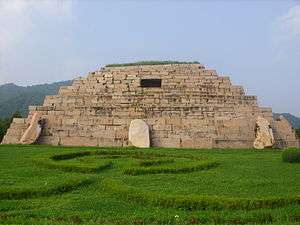Tomb of the General

The Tomb of the General (Traditional Chinese: 將軍冢, Simplified Chinese: 将军冢, Chinese: Jiangjun-zhong, Korean: Janggun-chong, Hangul: 장군총), also known as the Pyramid of the East, is thought to be the burial tomb of King Gwanggaeto or his son King Jangsu, both kings of a kingdom of Goguryeo. . .
The pyramid is located in Ji'an, Jilin province China, a former capital of Goguryeo. The pyramid was "rediscovered" in 1905. .
The base of the pyramid measures approximately 75 meters on each side, about half the size of the Egyptian pyramids and is eleven meters in height. . . The pyramid is composed of 1,100 dressed stone blocks. . Large stones, each measure approximately 3 x 5 meters were placed around the base of the pyramid and can still be seen today. . The monumental size of the tomb suggests that the Goguryeo elite were very powerful and the kingdom had the ability to mobilize large numbers of people for building projects. .
The pyramid-style tomb was typical of Goguryeo culture and was transmitted to the kingdom of Baekje's burial practices. .
The body of the dead elite was placed on a "stone base, surrounded by stones, and then surmounted by a rectangular platform or pyramid of dressed stones." . .
The design of the tombs incorporated entrances and passageways which facilitated grave robbery and so like most Goguryeo and Baekje tombs, the General's Tomb contains no archaeological artifacts. .
Four dolmen tombs were also placed on each corner of the pyramid. .
Kim Il-sung's reconstruction of the supposed tomb of Dangun is based on the Tomb of the General. .
See also
| Wikimedia Commons has media related to Tomb of the General. |